A simple nervous system
A) must include chemical senses, mechanoreception, and vision.
B) includes a minimum of 12 effector neurons.
C) has
information flow in only one direction: toward an integrating center.
D) has information flow in only one direction: away from an
integrating center.
E) includes sensory information, an
integrating center, and effectors.
E) includes sensory information, an integrating center, and effectors.
Which of the following is (are) characteristic of a simple nervous system?
a. a nerve net such as is found in cnidarians
b. nerve
cell ganglia
c. having electrical impulses traveling in both
directions
d. both A and C
e. A, B,and C
d. both A and C
* a nerve net such as is found in cnidarians
* c. having electrical impulses traveling in both directions
The heart rate decreases in response to the arrival of
A) acetylcholine.
B) epinephrine.
C) endorphin.
D) nitric oxide.
E) GABA.
A) acetylcholine.
Increases and decreases of the heart rate result from changes in the activity of the
A) corpus callosum.
B) medulla oblongata.
C)
thalamus.
D) pituitary.
E) cerebellum.
B) medulla oblongata.
An amino acid neurotransmitter that operates at inhibitory synapses in the brain is
A) acetylcholine.
B) epinephrine.
C) endorphin.
D) serotonin.
E) gamma-aminobutyric acid, GABA.
E) gamma-aminobutyric acid, GABA.
In the human knee-jerk reflex, as the calf is raised from the vertical toward the horizontal, the muscles of the quadriceps (flexors on the ventral side of the thighs) and the muscles of the hamstring (extensors on the dorsal side of the thighs) are
A) both excited and contracting.
B) both inhibited and
relaxed.
C) excited and inhibited, respectively.
D)
inhibited and excited, respectively.
C) excited and inhibited, respectively.
The stretch receptors of the sensory neurons in the human knee-jerk reflex are located in the
A) gastrocnemius muscle, in the calf.
B) cartilage of
the knee.
C) quadriceps, the flexor muscles on the ventral side
of the thighs.
D) hamstring, the extensor muscles on the dorsal
side of the thighs.
E) brain, the sensorimotor relay.
C) quadriceps, the flexor muscles on the ventral side of the thighs.
Cranial nerves originate in the brain and are thus part of the
A) central nervous system.
B) peripheral nervous system.
C) autonomic nervous system.
D) parasympathetic nervous
system.
E) sympathetic nervous system.
A) central nervous system.
Which of the following shows a brain structure correctly paired with one of its primary functions?
A) frontal lobedecision making
B) occipital
lobecontrol of skeletal muscles
C) temporal lobevisual
processing
D) cerebellumlanguage comprehension
E)
occipital lobespeech production
A) frontal lobedecision making
If you were writing an essay, the part of your brain that would be actively involved in this task is the
A) temporal and frontal lobes.
B) parietal lobe.
C) Broca's area.
D) Wernicke's area.
E) occipital lobe
A) temporal and frontal lobes.
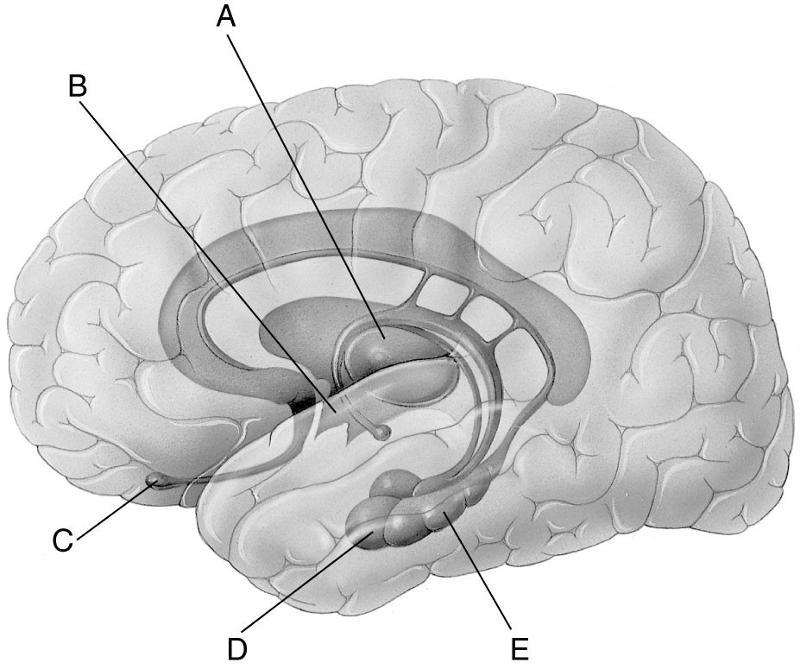
In the figure, which letter points to the amygdala?
A) A
B) B
C) C
D) D
E) E
D) D
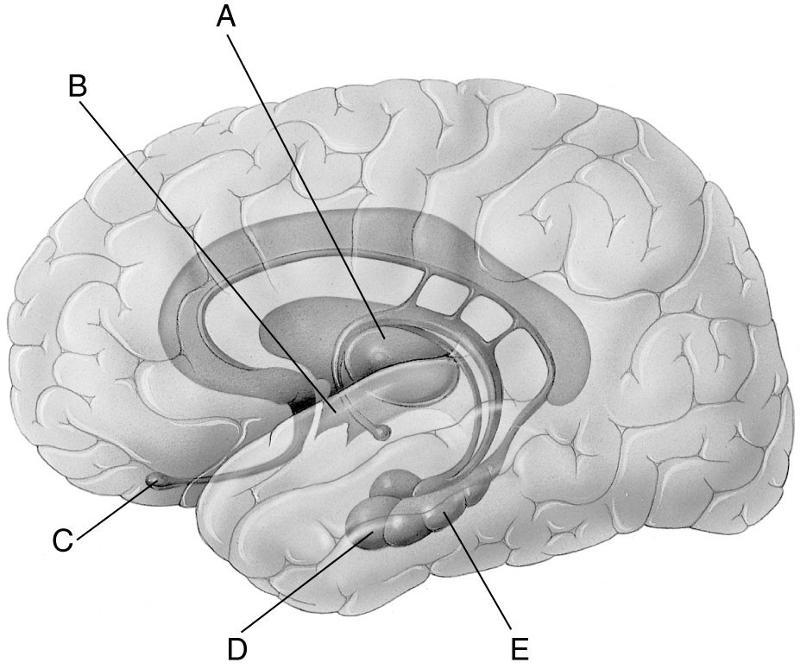
54) In the figure, which letter points to the thalamus?
A) A
B) B
C) C
D) D
E) E
A) A
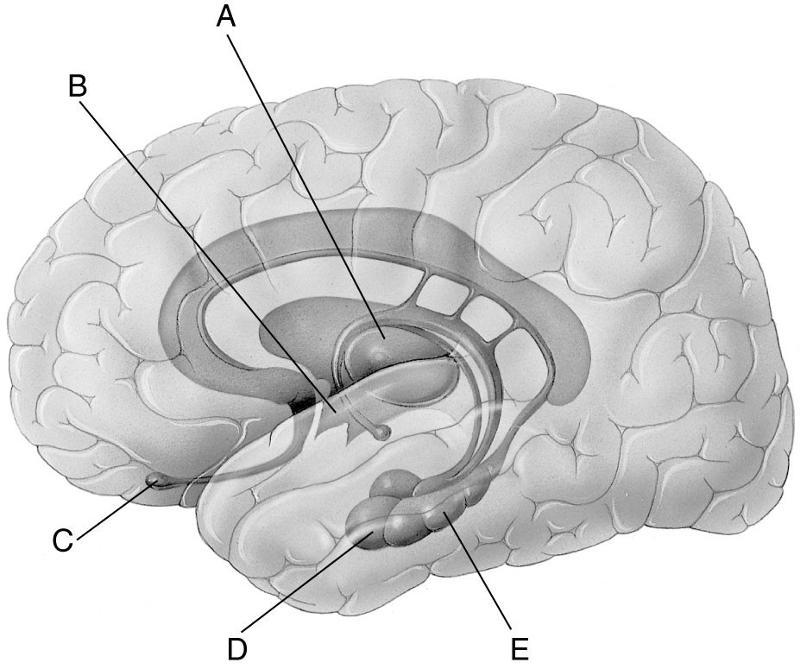
55) In the figure, which letter points to the olfactory bulb &
hippocampus?
A) A & B
B) B & C
C) C &
D
D) D & A
E) E& B
C) C & D
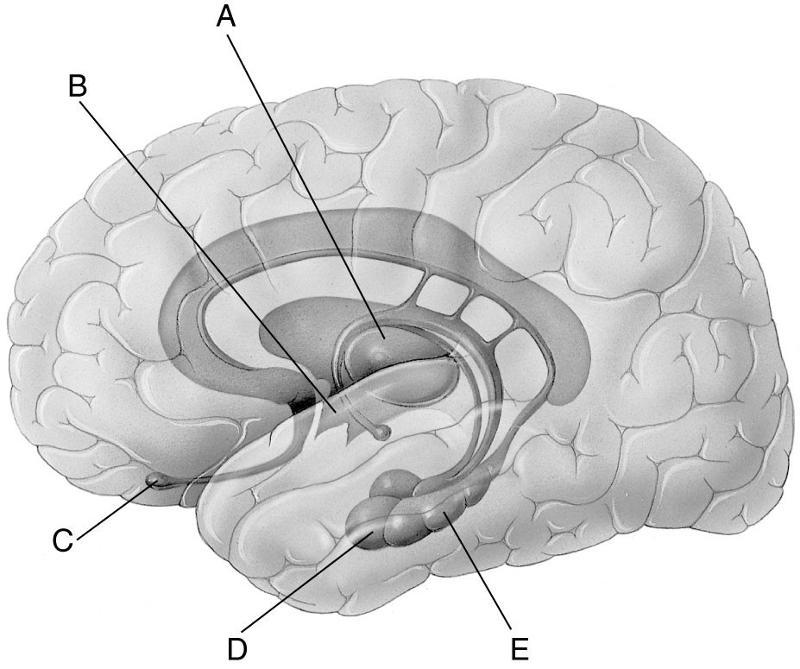
In the figure, which letter points to the hypothalamus?
A) A
B) B
C) C
D) D
E) E
D) D
The regulation of body temperature derives from the activity of the
A) cerebrum.
B) cerebellum.
C) thalamus.
D)
hypothalamus.
E) medulla oblongata.
D) hypothalamus.
Bipolar disorder is similar to schizophrenia in that researchers suspect that both include trouble with the neurotransmitter
A) dopamine.
B) acetylcholine.
C) norepinephrine.
D) nitric oxide.
E) ethanol.
A) dopamine
Bipolar disorder differs from schizophrenia in that
A) schizophrenia results in hallucinations.
B)
schizophrenia results in both manic and depressive states.
C)
schizophrenia results in decreased dopamine.
D) bipolar
disorder involves both genes and environment.
E) bipolar
disorder increases biogenic amines.
A) schizophrenia results in hallucinations.
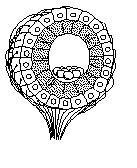
The structure diagrammed in the figure is the
A) neuromast.
B) statocyst.
C) taste bud.
D)
ommatidium.
E) olfactory bulb.
B) statocyst.
Sensory transduction of light/dark information in the vertebrate retina is accomplished by
A) ganglion cells.
B) amacrine cells.
C) bipolar
cells.
D) horizontal cells.
E) rods and cones.
E) rods and cones.
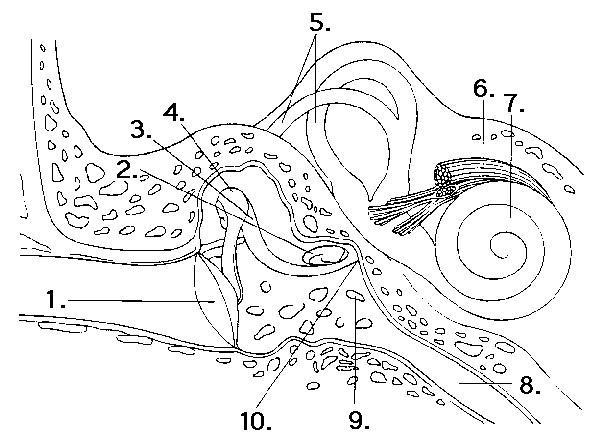
The structure involved in equalizing the pressure between the ear and the atmosphere is represented by number
A) 7.
B) 1.
C) 8.
D) 9.
E) 10
C) 8.
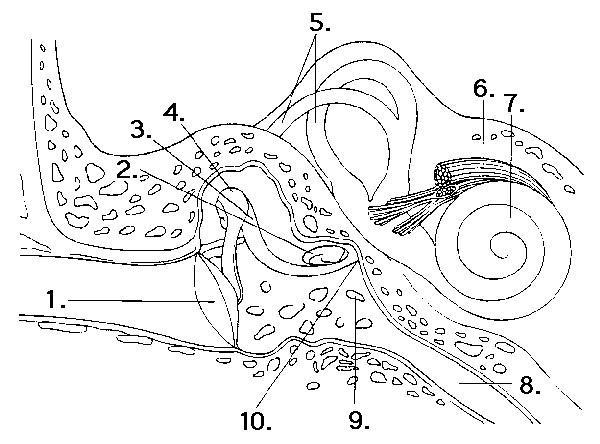
The sense of head motion begins with sensory transduction by the structures at which numbers?
A) 2, 3, and 4.
B) 2, 5, and 7.
C) 4.
D) 5.
E) 7 and 8.
D) 5

) Vibrations of the tympanic membrane to the oval window are
transmitted by the structures at which numbers?
A) 1, 2, 3, and
4.
B) 2, 3, and 4.
C) 3 and 4.
D) 4.
E) 5.
C) 3 and 4.
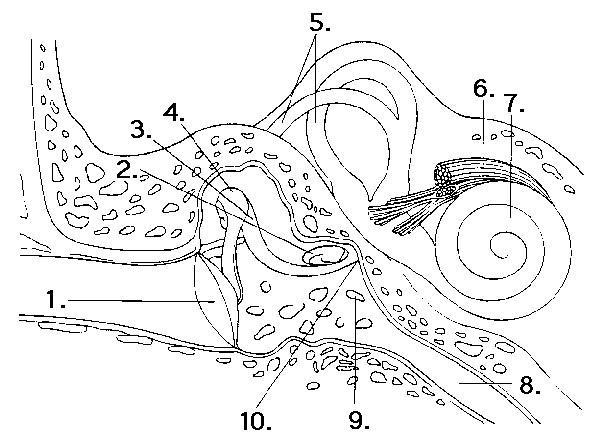
The organ of Corti is represented by which number?
A) 3.
B) 4.
C) 5.
D) 6.
E) 7.
E) 7.
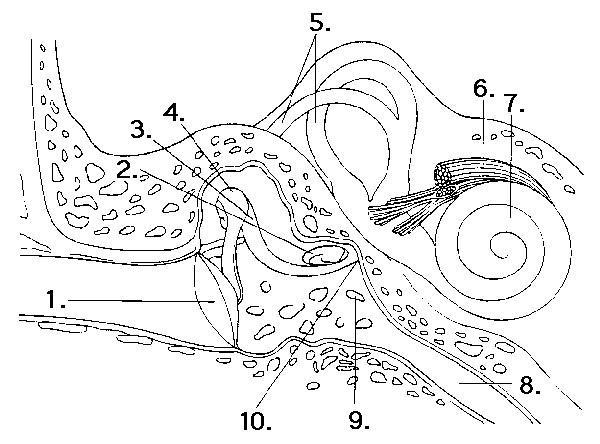
Hair cells are found in structures represented by numbers
A) 1 and 2.
B) 3 and 4.
C) 5 and 7.
D) 6 and
8.
E) 9 and 10.
C) 5 and 7.
Statocysts contain cells that are
A) mechanoreceptors which function in orientation to gravity.
B) chemoreceptors used in selecting migration routes.
C)
photoreceptors used in setting biological rhythms.
D)
thermoreceptors used in prey detection.
E) chemoreceptors used
in acid-base balance.
A) mechanoreceptors which function in orientation to gravity.
Muscle cells are stimulated by neurotransmitters released from the synaptic terminals of
A) T tubules.
B) motor neuron axons.
C) sensory
neuron axons.
D) motor neuron dendrites.
E) sensory
neuron dendrites.
B) motor neuron axons.
The hydrostatic skeleton of the earthworm allows it to move around in its environment by
A) walking on its limbs.
B) crawling with its feet.
C) swimming with its setae.
D) using peristaltic
contractions of its circular and longitudinal muscles.
E)
alternating contractions and relaxations of its flagellae.
D) using peristaltic contractions of its circular and longitudinal muscles.
Which of the following areas of study focuses on the exchange of energy, organisms, and materials between ecosystems?
A) population ecology
B) organismal ecology
C)
landscape ecology
D) ecosystem ecology
E) community ecology
C) landscape ecology
Ecology is
the scientific study of organisms interactions between themselves and the environment
Which of the following levels of ecological organization is arranged in the correct sequence from most to least inclusive?
A) community, ecosystem, individual, population
B)
ecosystem, community, population, individual
C) population,
ecosystem, individual, community
D) individual, population,
community, ecosystem
E) individual, community, population, ecosystem
B) ecosystem, community, population, individual
The oceans affect the biosphere in all of the following ways except
A) producing a substantial amount of the biosphere's oxygen.
B) removing carbon dioxide from the atmosphere.
C)
moderating the climate of terrestrial biomes.
D) regulating the
pH of freshwater biomes and terrestrial groundwater.
E) being
the source of most of Earth's rainfall.
D) regulating the pH of freshwater biomes and terrestrial groundwater.
Which series is correctly layered from top to bottom in a tropical rain forest?
A) ground layer, shrub/immature layer, under story, canopy,
emergent layer
B) canopy, emergent layer, under story,
shrub/immature layer, ground layer
C) canopy, under story,
shrub/immature layer, emergent layer, ground layer
D) emergent
layer, canopy, under story, shrub/immature layer, ground layer
E) emergent layer, under story, canopy, ground layer,
shrub/immature layer
D) emergent layer, canopy, under story, shrub/immature layer, ground layer
In the development of terrestrial biomes, which factor is most dependent on all the others?
A) the species of colonizing animals
B) prevailing
temperature
C) prevailing rainfall
D) mineral nutrient
availability
E) soil structure
A) the species of colonizing animals
Which of the following biomes is correctly paired with the description of its climate?
A) savanna–low temperature, precipitation uniform during the
year
B) tundra–long summers, mild winters
C) temperate
broadleaf forest–relatively short growing season, mild winters
D) temperate grasslands–relatively warm winters, most rainfall
in summer
E) tropical forests–nearly constant day length and temperature
E) tropical forests–nearly constant day length and temperature
Suppose that the number of bird species is determined mainly by the number of vertical strata found in the environment. If so, in which of the following biomes would you find the greatest number of bird species?
A) tropical rain forest
B) savanna
C) desert
D) temperate broadleaf forest
E) temperate grassland
A) tropical rain forest
Which of the following is characteristic of most terrestrial biomes?
A) annual average rainfall in excess of 250 cm
B) a
distribution predicted almost entirely by rock and soil patterns
C) clear boundaries between adjacent biomes
D) vegetation
demonstrating vertical layering
E) cold winter months
D) vegetation demonstrating vertical layering
Which of the following are important biotic factors that can affect the structure and organization of biological communities?
A) precipitation, wind
B) nutrient availability, soil pH
C) predation, competition
D) temperature, water
E)
light intensity, seasonality
C) predation, competition
Coral reefs can be found on the southern east coast of the United States but not at similar latitudes on the southern west coast. Differences in which of the following most likely account for this?
A) sunlight intensity
B) precipitation
C) day
length
D) ocean currents
E) salinity
D) ocean currents
Injury localized to the hypothalamus would most likely disrupt
A) short-term memory.
B) coordination during locomotion.
C) executive functions, such as decision making.
D)
sorting of sensory information.
E) regulation of body temperature.
E) regulation of body temperature.
A cow's herbivorous diet indicates that it is a(n)
A) primary consumer.
B) secondary consumer.
C)
decomposer.
D) autotroph.
E) producer.
A) primary consumer.
Which of the following ecosystems would likely have a larger net primary productivity/hectare and why?
A) open ocean because of the total biomass of photosynthetic
autotrophs
B) grassland because of the small standing crop
biomass that results from consumption by herbivores and rapid
decomposition
C) tropical rain forest because of the massive
standing crop biomass and species diversity
D) cave due to the
lack of photosynthetic autotrophs
E) tundra because of the
incredibly rapid period of growth during the summer season
B) grassland because of the small standing crop biomass that results from consumption by herbivores and rapid decomposition
Which of the following might be an investigation of microclimate?
A) the effect of ambient temperature on the onset of caribou
migration
B) the seasonal population fluctuation of nurse sharks
in coral reef communities
C) competitive interactions between
various species of songbirds during spring migration
D) the
effect of sunlight intensity on species composition in a decaying rat
carcass
E) the effect of different nitrogen applications on corn productivity
D) the effect of sunlight intensity on species composition in a decaying rat carcass
Which of the following is an ecosystem?
A)all of the
angelfish in your aquarium
B)all of the organisms living in
your aquarium
C)all of the angelfish on the planet
D)all
of the organisms living in your aquarium and the abiotic factors with
which they interact
E)the water, temperature, rocks, and other
abiotic components of the aquarium
D)all of the organisms living in your aquarium and the abiotic factors with which they interact
How do iron levels affect phytoplankton populations in a marine ecosystem?
A)Without iron, eukaryotic phytoplankton populations fall
because they cannot convert atmospheric N2 to nitrogenous minerals.
B)In the presence of too much iron, eukaryotic phytoplankton
populations fall because they cannot convert atmospheric N2 to
nitrogenous minerals.
C)Iron stimulates the growth of
cyanobacteria, which convert atmospheric N2 to nitrogenous minerals,
stimulating the growth of phytoplankton.
D)Iron halts the
growth of cyanobacteria, which convert atmospheric N2 to nitrogenous
minerals; therefore, phytoplankton populations are limited.
E)Nitrogen and phosphorus are the only known limiting nutrients
in marine ecosystems.
C)Iron stimulates the growth of cyanobacteria, which convert atmospheric N2 to nitrogenous minerals, stimulating the growth of phytoplankton.
Which of the following can be said about light in aquatic environments?
A) Water selectively reflects and absorbs certain wavelengths
of light.
B) Photosynthetic organisms that live in deep water
probably use red light.
C) Longer wavelengths penetrate to
greater depths.
D) Light penetration seldom limits the
distribution of photosynthetic species.
E) Most photosynthetic
organisms avoid the surface where the light is too intense.
A) Water selectively reflects and absorbs certain wavelengths of light.
In which of the following terrestrial biome pairs are both parts dependent upon periodic burning?
A) tundra and coniferous forest
B) chaparral and savanna
C) desert and savanna
D) tropical forest and temperate
broadleaf forest
E) grassland and tundra
B) chaparral and savanna
A population of ground squirrels has an annual per capita birth rate of 0.06 and an annual per capita death rate of 0.02. Calculate an estimate of the number of individuals added to (or lost from) a population of 1,000 individuals in one year.
A) 120 individuals added
B) 40 individuals added
C)
20 individuals added
D) 400 individuals added
E) 20
individuals lost
B) 40 individuals added During exponential growth, a population always
During exponential growth, a population always
A) grows by thousands of individuals.
B) grows at its
maximum per capita rate.
C) quickly reaches its carrying
capacity.
D) cycles through time.
E) loses some
individuals to emigration.
B) grows at its maximum per capita rate.
Why do some invertebrates, such as lobsters, show a "stair-step" survivorship curve?
A) Many invertebrates mate and produce offspring on multiyear
cycles.
B) Within a species of invertebrates, younger
individuals have a higher survivorship than older individuals.
C) Many invertebrates molt in order to grow, and they are
vulnerable to predation during their "soft shell" stage.
D) Many invertebrate species have population cycles that go up
and down according to the frequency of sunspots.
E) The number
of fertilized eggs that mature to become females in many species of
invertebrates is based on ambient temperature.
C) Many invertebrates molt in order to grow, and they are vulnerable to predation during their "soft shell" stage.
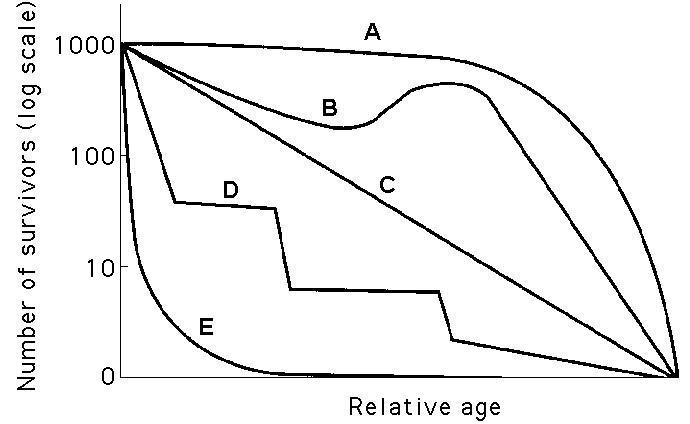
Which curve best describes survivorship in marine molluscs?
A) A
B) B
C) C
D) D
E) E
E) E
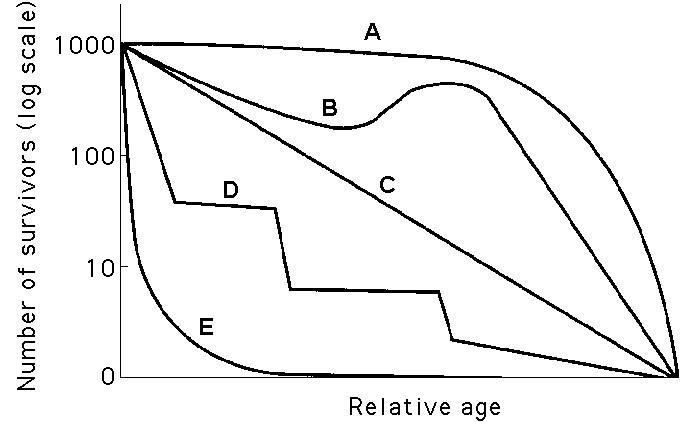
Which curve best describes survivorship in elephants?
A) A
B) B
C) C
D) D
E) E
A) A
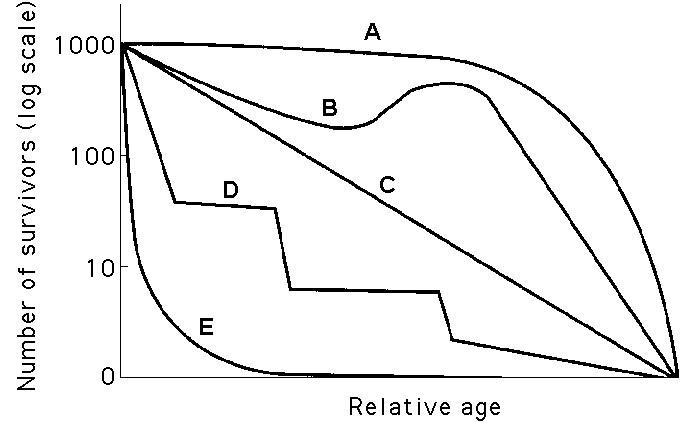
Which curve best describes survivorship in a marine crustacean that molts?
A) A
B) B
C) C
D) D
E) E
D) D
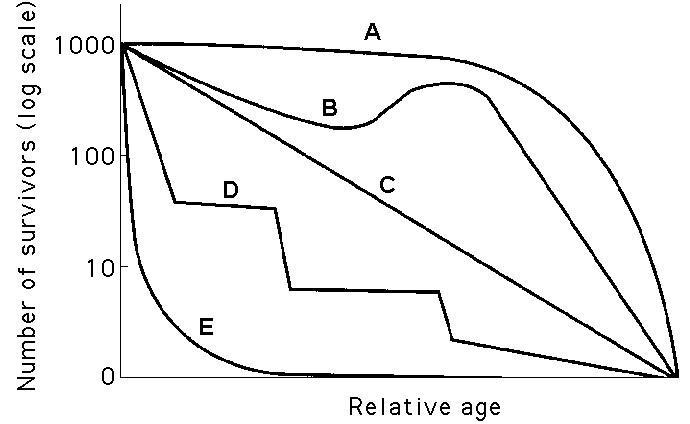
Which curve best describes survivorship in humans who live in undeveloped nations?
A) A
B) B
C) C
D) D
E) E
A) A
Which of the following statements about the evolution of life histories is correct?
A) Stable environments with limited resources favor r-selected
populations.
B) K-selected populations are most often found in
environments where density-independent factors are important
regulators of population size.
C) Most populations have both r-
and K-selected characteristics that vary under different environmental
conditions.
D) The reproductive efforts of r-selected
populations are directed at producing just a few offspring with good
competitive abilities.
E) K-selected populations rarely approach
carrying capacity
C) Most populations have both r- and K-selected characteristics that vary under different environmental conditions.
Which of the following is characteristic of K-selected populations?
A) offspring with good chances of survival
B) many
offspring per reproductive episode
C) small offspring
D)
a high intrinsic rate of increase
E) early parental reproduction
A) offspring with good chances of survival
Which pair of terms most accurately describes life history traits for a stable population of wolves?
A) semelparous; r-selected
B) semelparous; K-selected
C) iteroparous; r-selected
D) iteroparous; K-selected
E) iteroparous; N-selected
D) iteroparous; K-selected
Carrying capacity is
A) seldom reached by marine producers and consumers because of
the vast resources of the ocean.
B) the maximum population size
that a particular environment can support.
C) fixed for most
species over most of their range most of the time.
D)
determined by density and dispersion data.
E) the term used to
describe the stress a population undergoes due to limited resources.
B) the maximum population size that a particular environment can support.
A population's carrying capacity
A) may change as environmental conditions change.
B) can
be accurately calculated using the logistic growth model.
C)
generally remains constant over time.
D) increases as the per
capita growth rate (r) decreases.
E) can never be exceeded.
A) may change as environmental conditions change.
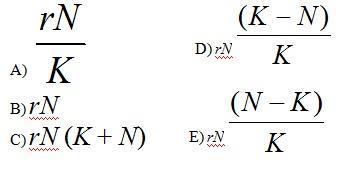
Exponential growth of a population is represented by dN/dt =
Answer: B
Which of the following is the equation for zero population growth (ZPG)?
A) R = b - m
B) dN/dt = rN
C) dN/dt =rmax N (K -N)/K
D) dN/dt =rmax N
E) dN/dt = 1.0N
A) R = b - m

Logistic growth of a population is represented by dN/dt =
Answer: D
Which of the following is an example of cryptic coloration?
A) bands on a coral snake
B) brown or gray color of tree
bark
C) markings of a viceroy butterfly's wings
D) colors
of an insect-pollinated flower's petals
E) a "walking
stick" insect that resembles a twig
E) a "walking stick" insect that resembles a twig
Which of the following is an example of aposematic coloration?
A) stripes of a skunk
B) eye color in humans
C)
green color of a plant
D) colors of an insect-pollinated flower
E) a katydid whose wings look like a dead leaf
A) stripes of a skunk
Which of the following is an example of Müllerian mimicry?
A) two species of unpalatable butterfly that have the same color
pattern
B) a day-flying hawkmoth that looks like a wasp
C)
a chameleon that changes its color to look like a dead leaf
D)
two species of rattlesnakes that both rattle their tails
E) two
species of moths with wing spots that look like owl's eyes
A) two species of unpalatable butterfly that have the same color pattern
Evidence shows that some grasses benefit from being grazed. Which of the following terms would best describe this plant-herbivore interaction?
A) mutualism
B) commensalism
C) parasitism
D)
competition
E) predation
A) mutualism
Dwarf mistletoes are flowering plants that grow on certain forest trees. They obtain nutrients and water from the vascular tissues of the trees. The trees derive no known benefits from the dwarf mistletoes. Which of the following best describes the interactions between dwarf mistletoes and trees?
A) mutualism
B) parasitism
C) commensalism
D)
facilitation
E) competition
B) parasitism
Which of the following terms is used by ecologists to describe the community interaction where one organism makes the environment more suitable for another organism?
A) parasitism
B) mutualism
C) inhibition
D)
facilitation
E) commensalism
D) facilitation
Which of the following would be most significant in understanding the structure of an ecological community?
A) determining how many species are present overall
B)
determining which particular species are present
C) determining
the kinds of interactions that occur among organisms of different
species
D) determining the relative abundance of species
E) determining how many species are present overall, which
particular species are present, the kinds of interactions that occur
among organisms of different species, and the relative abundance of species
E) determining how many species are present overall, which particular species are present, the kinds of interactions that occur among organisms of different species, and the relative abundance of species
To recycle nutrients, an ecosystem must have, at a minimum,
A) producers.
B) producers and decomposers.
C)
producers, primary consumers, and decomposers.
D) producers,
primary consumers, secondary consumers, and decomposers.
E)
producers, primary consumers, secondary consumers, top carnivores,
and decomposers.
B) producers and decomposers.
Secondary consumers that can eat only primary consumers receive what percent of the energy fixed by primary producers in a typical field ecosystem?
A) 0.1%
B) 1%
C) 10%
D) 20%
E) 80%
B) 1%
If you applied a fungicide to a cornfield, what would you expect to happen to the rate of decomposition and net ecosystem production (NEP)?
A) Both decomposition rate and NEP would decrease.
B) Both
decomposition rate and NEP would increase.
C) Neither would
change.
D) Decomposition rate would increase and NEP would
decrease.
E) Decomposition rate would decrease and NEP would increase.
E) Decomposition rate would decrease and NEP would increase.
Aquatic primary productivity is most limited by which of the following?
A) light and nutrient availability
B) predation by primary
consumers
C) increased pressure with depth
D) pollution
E) temperature
A) light and nutrient availability
What is the primary limiting factor for aquatic productivity?
A) pressure
B) lack of nutrients
C) light
availability
D) herbivores
E) competition
B) lack of nutrients
Which of the following is the most accepted hypothesis as to why invasive species take over communities into which they have been introduced?
A) Invasive species are more aggressive than native species in
competing for the limited resources of the environment.
B)
Invasive species are not held in check by the predators and agents of
disease that have always been in place for the native species.
C) Humans carefully select which species will outcompete
nuisance native species.
D) Invasive species have a higher
reproductive potential than native species.
E) Invasive species
come from geographically isolated regions, so when they are introduced
to regions where there is more competition, they thrive.
B) Invasive species are not held in check by the predators and agents of disease that have always been in place for the native species.
Which data is most useful to measure primary productivity in a
terrestrial ecosystem?
A) temperature readings
B)
potential evapotranspiration
C) intensity of solar radiation
D) annual precipitation
E) amount of carbon fixed
D) annual precipitation
This term refers to the reflecting and absorption of infrared radiation by atmospheric methane, carbon dioxide, and water.
A) depletion of ozone layer
B) acid precipitation
C)
biological magnification
D) greenhouse effect
E) eutrophication
D) greenhouse effect
During the course of the formation of a parasite/host relationship, a critical first step in this evolution would be
A) changing the behavior of the host or intermediate host.
B) developing asexual reproduction.
C) deriving
nourishment without killing the host.
D) starting as an
ectoparasite and then later becoming an endoparasite.
E)
utilizing heterotropic nutrition during infection and autotrophic
nutrition during dormancy.
C) deriving nourishment without killing the host.
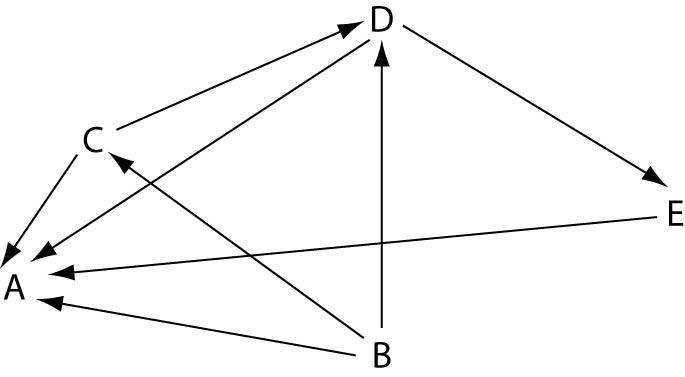
Which letter represents an organism that could be a carnivore?
A) A
B) B
C) C
D) D
E) E
E) E

Which letter represents an organism that could be a producer?
A) A
B) B
C) C
D) D
E) E
B) B
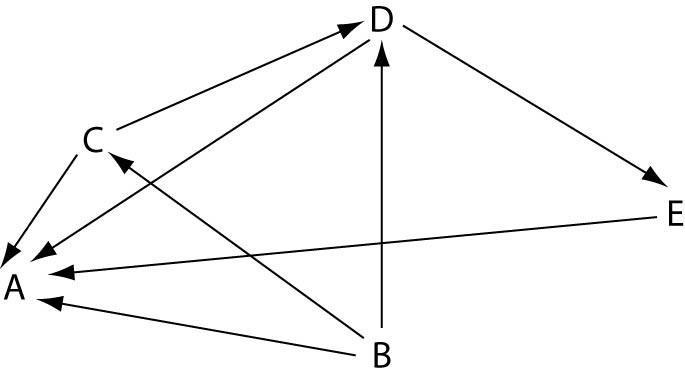
Which letter represents an organism that could be a primary consumer?
A) A
B) B
C) C
D) D
E) E
C) C
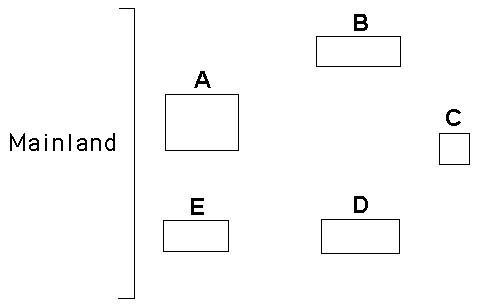
Which island would likely have the greatest species diversity?
A) A
B) B
C) C
D) D
E) E
A) A

Which island would likely exhibit the most impoverished species
diversity?
A) A
B) B
C) C
D) D
E) E
C) C
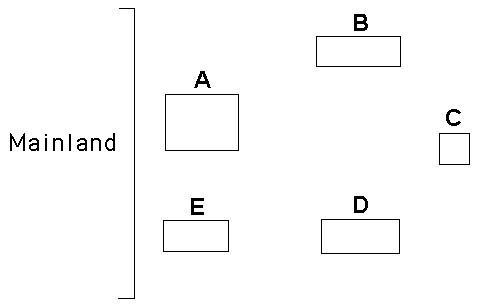
Which island would likely have the lowest extinction rate?
A) A
B) B
C) C
D) D
E) E
A) A